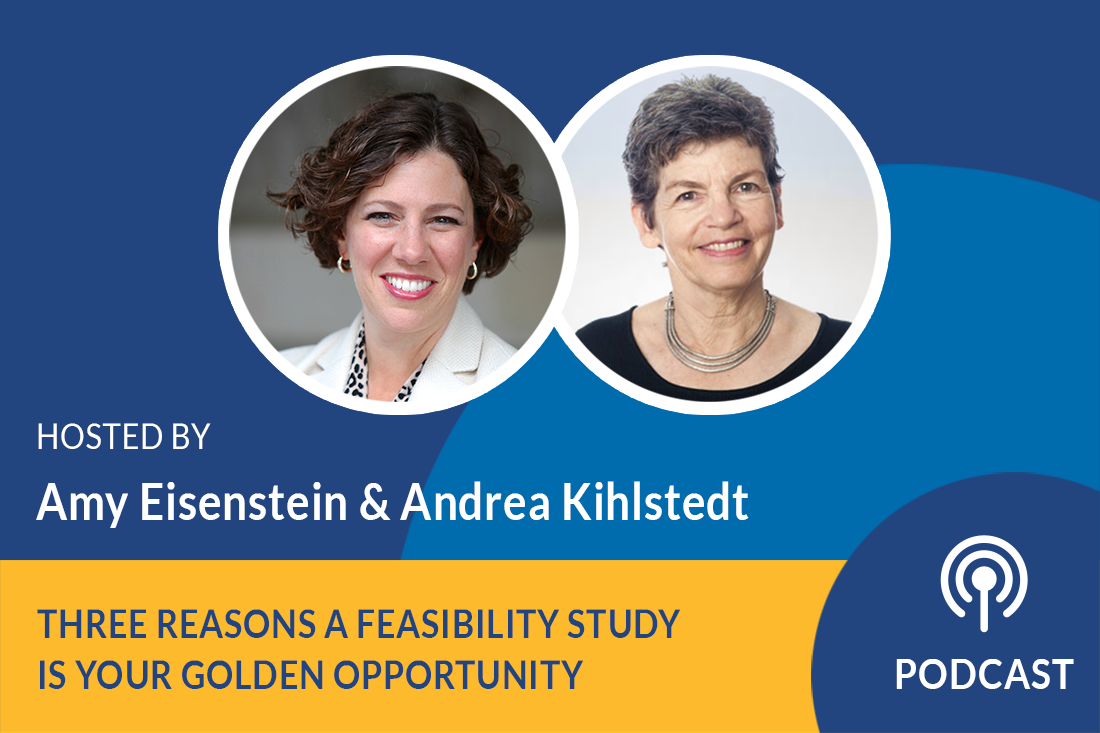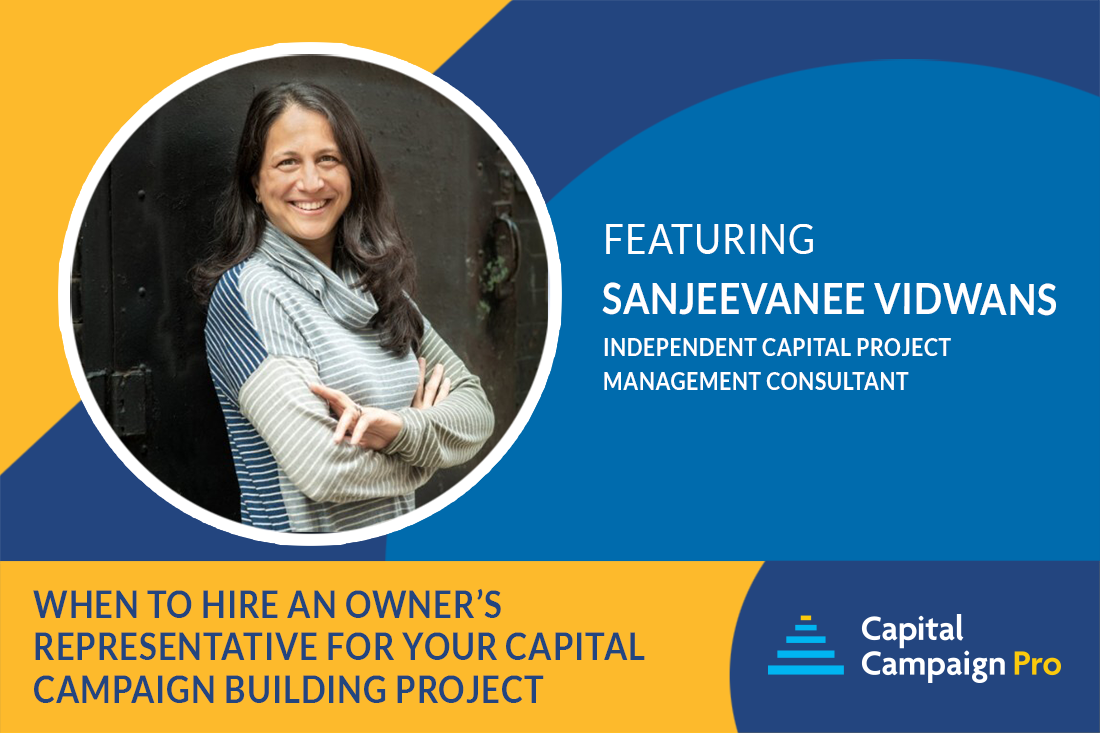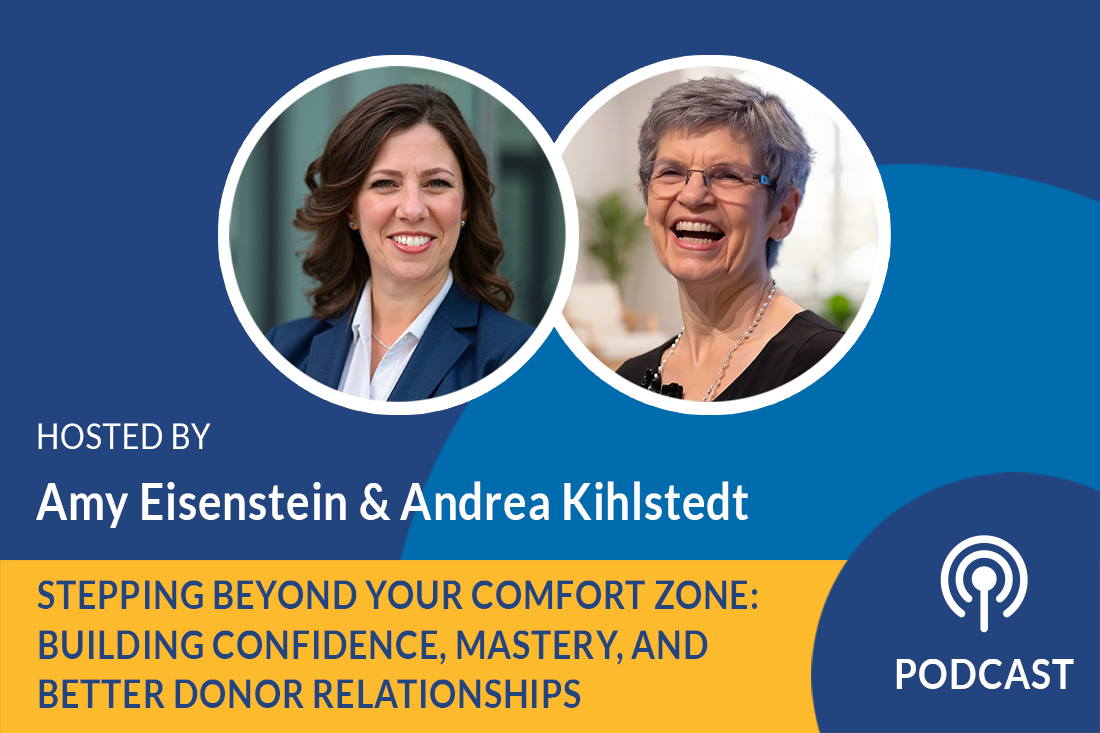Podcast: Three Reasons a Feasibility Study is your Golden Opportunity

Season 4, Episode 39
Should you do a feasibility study? In this episode, campaign experts Amy Eisenstein and Andrea Kihlstedt think feasibility studies are a must. And they tell you how to respond to penny-pinching board members who resist.
Listen Now:
Stream the episode above, or click here to find it on Spotify. You can also find all episodes on your favorite streaming platform.
Amy Eisenstein:
One of the most frequent questions we get at Capital Campaign Pro is, do I really need to do a feasibility study? Of course, we think the answer is yes, and we’re going to tell you why.
Hi, I am Amy Eisenstein. I’m here with my co-founder and colleague, Andrea Kihlstedt, and today we’re talking about feasibility studies. The reality is that somebody on your leadership team, your board or your key staff members believes that you can just skip a feasibility study and plunge headfirst into your campaign, but we’re going to tell you why that’s a bad idea and how to talk to those people about the importance of a feasibility study.
Andrea, let’s dive in. Why is it such an important thing for organizations considering a campaign, seriously considering a campaign to begin with a feasibility study?
Why to Start Your Capital Campaign with a Feasibility Study
Andrea Kihlstedt:
Well, Amy, most organizations go into a campaign having a pretty clear idea of what they need, how much money they need, and they may have a list of donors that they’re hopeful they will get gifts from, but they almost always have a very hazy notion about how much they can really raise.
To go into a campaign without some clarity about whether donors will be there with the big gifts that you need for a campaign is just simply not wise. No one should go into a capital campaign with a very high risk of failure.
A feasibility study keeps you from doing that and gives you enough information so that your judgment about how much money you will be able to raise through your campaign is informed. Maybe not perfectly informed, but informed enough so that it will give you and your board the confidence to move ahead with a campaign.
A Feasibility Study Sets Your Campaign Up for Success
Amy Eisenstein:
I would take it even a step farther and say that a feasibility study actually sets you up for success, because it helps you plan a strategic and thoughtful campaign with the right donors in mind and helps you engage them right from the start. Not only does it mitigate the risk, but it actually helps in many cases set you up for success. Let’s talk about why. What are the key components of a feasibility study and what do they do to help you know what you can raise and to set you up for success?
Andrea Kihlstedt:
The most important part of a feasibility study is that you’ll have an opportunity, either you or your consultant, will have an opportunity to talk to your largest potential donors; the people you have identified as the most likely to give the big gifts you’re going to need for your campaign’s success.
In those conversations, you’re going to get an idea of what those people think of what it is you’re planning, and whether, when the time is right, they will consider giving a gift at the level that you will need. That’s worth a tremendous amount to find out that information and those conversations are just vitally important.
- They engage the donors in a real conversation.
- They inform you what your donors are thinking.
In some cases, you may be surprised at how excited your donors are, and in other cases, you may realize that you’re barking up the wrong tree because you can’t find donors who are as excited about your project as you are.
A Guided Feasibility Study Provides Additional Benefits
Amy Eisenstein:
Yeah. I think you sort of glossed over this idea of who’s talking to the donors during a feasibility study. In many instances, a capital campaign consultant goes out and talks to the key donors of an organization. In our model at Capital Campaign Pro, we have you, the leaders of the nonprofit, key staff members, usually the executive director, the development director, maybe a board member or two do actually have those important conversations, and we guide you carefully through the process.
We call it a Guided Feasibility Study, where we’re supporting you every step of the way, but it’s super important because this actually is a game changer, this model of feasibility studies that we do here at the toolkit, because it sets organizations up for success later on with solicitation because the board and staff are already out there having these very important conversations with their donors, and it takes away the mystery of it all, I would say.
Anyways. Alright. Engaging your first donor, your best donors early, that’s key. Getting them on board, finding out what they think about the campaign, letting them in on the early planning process of the campaign. That’s number one. Number two…
A Feasibility Study Forces You to Discern Your Donors
Andrea Kihlstedt:
Amy, in order to get to number two, you of course start by having a real focus about who those people are you need to be talking to. I think for many organizations they haven’t yet had the discipline to do that.
A feasibility study forces you to have the discipline to sit down and ask:
- Who are the people we need to be talking to?
- Who are our most important donors?
- Who are the people who are right under our noses that we know about, and then who are the people who couldn’t give a significant gift, but we haven’t cultivated or brought them in quite so close yet? Why don’t we go talk to them as well?
The study process itself will discipline you to do the work that needs to be done.
Amy Eisenstein:
That is for very practical reasons because you or a consultant cannot interview hundreds of people. It forces you to focus on 20, 30, 40, 50 people, the number that is practical and reasonable to interview, and you are not going to interview random people. You’re going to interview people who have the ability to help the campaign succeed.
If you interview the wrong people, you’ve missed the boat. The process, the feasibility study process, actually forces you to pay attention to who can make this campaign successful. That’s who we need to talk to in this early study process.
Andrea Kihlstedt:
Amy, that’s so important. Every once in a while, someone who has done a feasibility study will say to me, I couldn’t understand how the consultants could make a recommendation about our campaign. They didn’t get to talk to any of our largest donors. I was thinking to myself, what a mistake.
What a miss that is, because you can’t tell whether your project is feasible unless you have those really important conversations with the people who might be able to give those large gifts, so don’t give up on that.
Amy Eisenstein:
Right. Work hard to get those conversations.
Now, if you’ve really worked strategically and thoughtfully and methodically about getting those people to talk to you and your top 10 prospects refuse to have early conversations, guess what? That might be telling you something about the potential success of your campaign.
If they won’t talk to you when you’re not asking for a gift, what are the chances that they’re going to turn around in six months and start talking to you? That’s your early red flag warning sign. Don’t ignore it. Alright.
Andrea Kihlstedt:
Exactly.
A Feasibility Study Gives You Early Insight
Amy Eisenstein:
Number three, the reason to do a feasibility study is because it tells you what’s realistic. You will learn from talking to your biggest potential donors whether they’re on board. If half the people you talk to say, no, I’m not really sure, I can’t commit anything, I don’t want to participate, I’m not loving this project, you haven’t gone down the road of a campaign yet and you may have to make some very difficult decisions.
You also may be able to say with enthusiasm to the board, we’ve got our top donors on board. They’re in. It gives you a real sense of what’s real and what’s not real. The idea of plunging into a campaign with your head in the sand if you don’t do a feasibility study, to me, it’s silly. It’s saying, alright, we’re going to do this big project, but we have no idea and no data as to whether or not we can do it. That’s the real reason to do a feasibility study.
Andrea Kihlstedt:
Yeah. That’s the ostrich approach, Amy.
Amy Eisenstein:
Right. Put your head in the sand.
Andrea Kihlstedt:
Go ahead with the campaign. Three quarters of the way down the road you realize you’re not going to raise the money, and then you are stuck with a failing campaign. You do not want to be in that situation. You want to take your head out of the sand, go talk to your largest donors, find out if this is a project they’re going to be willing to consider supporting at a high level. If they are, then you can move ahead with some degree of confidence that you’re heading in the right direction. It’s so important.
Amy Eisenstein:
I think this is the ultimate example of penny-wise pound-foolish, when people skip a feasibility study. They say, oh my gosh, it’s $30,000 or $50,000. Well, if you’re doing a multimillion-dollar campaign, even a $2 million or $3 million campaign, it should be half a percent or 1% or less than that. As the campaign gets bigger, five million, 10 million, 100 dollars, it’s a teeny tiny fraction of what you’re setting out to raise, so the idea of going in blind, that’s what comes to mind, penny-wise pound-foolish.
Andrea Kihlstedt:
Amy, I think this is a subject we know well. I think in a future podcast we need to dig into how to do a feasibility study our way, the toolkit way. I think we made such an interesting innovation in this field, and we really should spend some time talking about it for our listeners.
Amy Eisenstein:
Yeah. If you are listening, of course, and getting ready to do a feasibility study or thinking about it, please do visit the Capital Campaign Pro website, sign up to have a strategy session with one of our experts to talk about how we can help you do this in the most effective and efficient way possible. Thank you so much for joining us, and we will talk to you next time.



Leave a Comment